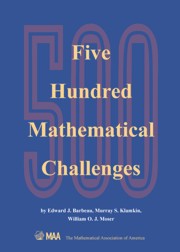Book contents
PREFACE
Summary
This collection of problems is directed to students in high school, college and university. Some of the problems are easy, needing no more than common sense and clear reasoning to solve. Others may require some of the results and techniques which we have included in the Tool Chest. None of the problems require calculus, so the collection could be described as “problems in pre-calculus mathematics”. How- ever, they are definitely not the routine nor “drill” problems found in textbooks. They could be described as challenging, interesting, thought-provoking, fascinating. Many have the “stuff” of real mathematics; indeed quite a few are the simplest cases of research-level problems. Hence they should provide some insight into what mathematical research is about.
The collection is dedicated to students who find pleasure in wrestling with, and finally overcoming, a problem whose solution is not apparent at the outset. It is also dedicated to teachers who encourage their students to rise above the security offered by prefabricated exercises and thus experience the creative side of mathematics. Teachers will find here problems to challenge mathematically oriented students, such as may be found in mathematics clubs or training sessions for mathematical competitions. Seeking solutions could be a collective experience, for collaboration in research often succeeds when a lonely effort might not.
Pay no attention to the solutions until your battle with a problem has resulted in a resounding victory or disappointing defeat. The solutions we have given are not to be regarded as definitive, although they may suggest possibilities for exploring similar situations.
Information
- Type
- Chapter
- Information
- 500 Mathematical Challenges , pp. vii - viiiPublisher: Mathematical Association of AmericaPrint publication year: 1995
